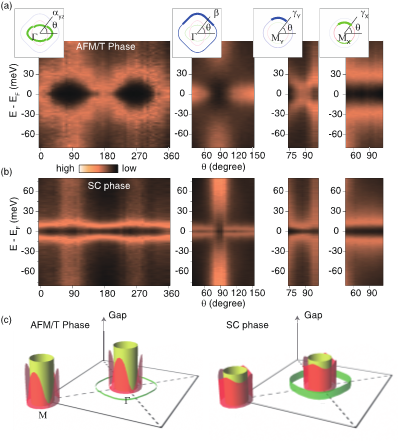Experimental progress of Yan Zhang's group about the isostructural spin-density-wave and superconducting gap anisotropies in iron-arsenide
Time:2020-07-09ClickTimes:
The mechanism of high-Tcsuperconductivity is one of the most challenging questions in condensed matter physics. Since high-Tcsuperconductivity always intertwines with the magnetic symmetry breaking states,understanding the connection between the superconducting and magnetic states is thus crucial. It is directly related to the superconducting pairing mechanism. Iron-based superconductors are recently discovered high-Tcsuperconductors. Their phase diagram consists both superconducting phase and collinear spin-density-wave (SDW) phase. However, how these two phases are connected remains controversial.
Gap structure measurement is an effective experimental method to study phase transitions. Electronic system saves energy by opening energy gaps at the Fermi level in the symmetry breaking phases. Energy gap distribution in momentum space reflects the detailed form of interactions. For iron-based superconductors, the superconducting gap structure has been intensively studied. However, in contrast to the superconducting gap structure, the detailed delineation of the SDW gap structure is still uncovered so far. One complexity comes from the two-fold rotational symmetry of the SDW phase. The band structure is complicated by the nematic band splitting and sample twinning effect.
Recently, the Yan Zhang’s group of International Center for Quantum Materials (ICQM) at Peking University succeeded in measuring the detailed SDW gap anisotropies in the iron-based superconductors utilizing the self-built high-resolution angle resolved photoelectron spectroscopy (ARPES) and Stanford Synchrotron Radiation Light source (SSRL) Beamline 5-4. Firstly, they synthesized high-quality Sr1-xNaxFe2As2single crystals which shows a tetragonal magnetic phase (AFM/T). In the AFM/T phase, the rotational symmetry recovers from two-fold to four-fold. By avoiding the sample twinning effect, this reduces the observed electronic bands by half, which is essential for the gap measurement. Meanwhile, they succeed in suppressing the surface state and revealing the bulk electronic state by using the surface charge compensation method. Based on all above experimental efforts, the detailed SDW gaps on all Fermi surface sheets have been measured in details with unpreceded precision. At the same time, similar experiment was conducted also on the superconducting samples. By comparing the experimental results on both the superconducting and the AFM/T phases, they found that the SDW gap and superconducting gap share many similarities, including their angular symmetry, relative gap size on different Fermi pockets, and gap minima and maxima locations (Fig.1). This shows that the superconducting phase is closely related to magnetic phase, and the superconducting pairing interaction and magnetic interaction may share the same origin. It provides important experimental evidences for understanding the superconducting pairing mechanism in iron-based high-temperature superconductors.

FIG. 1: (color online) The comparison of gap anisotropies taken in the AFM/T and superconducting phases. (a) The SDW gap distributions on different Fermi surface sheets taken in the AFM/T phase on sample #1. (b) is the same as a, but taken in the superconducting phase on sample #2. (c) The schematic of the SDW and superconducting gap anisotropies.
This work has been published in Physical Review Letter on June 19th, 2020(https://doi.org/10.1103/PhysRevLett.124.247002). Yan Zhang at Peking University is the corresponding author. The first author of the paper is Tingting Han, a doctoral student of Yan Zhang’s group in ICQM. This work was supported by National Natural Science Foundation of China, the National Key Research and Development Program of China
